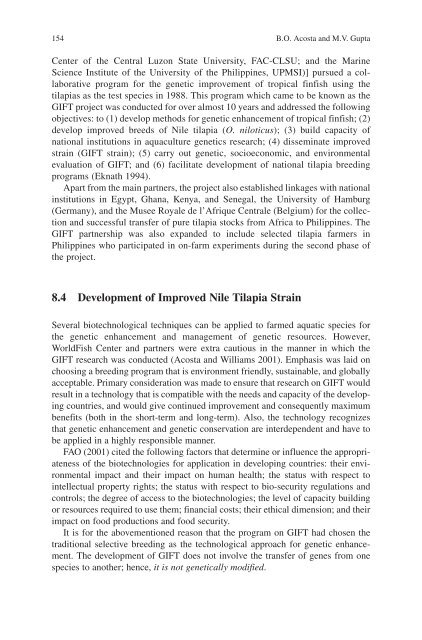Success Stories In Asian Aquaculture - Library - Network of ...
Success Stories In Asian Aquaculture - Library - Network of ...
Success Stories In Asian Aquaculture - Library - Network of ...
- No tags were found...
Create successful ePaper yourself
Turn your PDF publications into a flip-book with our unique Google optimized e-Paper software.
154 B.O. Acosta and M.V. GuptaCenter <strong>of</strong> the Central Luzon State University, FAC-CLSU; and the MarineScience <strong>In</strong>stitute <strong>of</strong> the University <strong>of</strong> the Philippines, UPMSI)] pursued a collaborativeprogram for the genetic improvement <strong>of</strong> tropical finfish using thetilapias as the test species in 1988. This program which came to be known as theGIFT project was conducted for over almost 10 years and addressed the followingobjectives: to (1) develop methods for genetic enhancement <strong>of</strong> tropical finfish; (2)develop improved breeds <strong>of</strong> Nile tilapia ( O. niloticus ); (3) build capacity <strong>of</strong>national institutions in aquaculture genetics research; (4) disseminate improvedstrain (GIFT strain); (5) carry out genetic, socioeconomic, and environmentalevaluation <strong>of</strong> GIFT; and (6) facilitate development <strong>of</strong> national tilapia breedingprograms (Eknath 1994) .Apart from the main partners, the project also established linkages with nationalinstitutions in Egypt, Ghana, Kenya, and Senegal, the University <strong>of</strong> Hamburg(Germany), and the Musee Royale de l’Afrique Centrale (Belgium) for the collectionand successful transfer <strong>of</strong> pure tilapia stocks from Africa to Philippines. TheGIFT partnership was also expanded to include selected tilapia farmers inPhilippines who participated in on-farm experiments during the second phase <strong>of</strong>the project.8.4 Development <strong>of</strong> Improved Nile Tilapia StrainSeveral biotechnological techniques can be applied to farmed aquatic species forthe genetic enhancement and management <strong>of</strong> genetic resources. However,WorldFish Center and partners were extra cautious in the manner in which theGIFT research was conducted (Acosta and Williams 2001) . Emphasis was laid onchoosing a breeding program that is environment friendly, sustainable, and globallyacceptable. Primary consideration was made to ensure that research on GIFT wouldresult in a technology that is compatible with the needs and capacity <strong>of</strong> the developingcountries, and would give continued improvement and consequently maximumbenefits (both in the short-term and long-term). Also, the technology recognizesthat genetic enhancement and genetic conservation are interdependent and have tobe applied in a highly responsible manner.FAO (2001) cited the following factors that determine or influence the appropriateness<strong>of</strong> the biotechnologies for application in developing countries: their environmentalimpact and their impact on human health; the status with respect tointellectual property rights; the status with respect to bio-security regulations andcontrols; the degree <strong>of</strong> access to the biotechnologies; the level <strong>of</strong> capacity buildingor resources required to use them; financial costs; their ethical dimension; and theirimpact on food productions and food security.It is for the abovementioned reason that the program on GIFT had chosen thetraditional selective breeding as the technological approach for genetic enhancement.The development <strong>of</strong> GIFT does not involve the transfer <strong>of</strong> genes from onespecies to another; hence, it is not genetically modified .
















